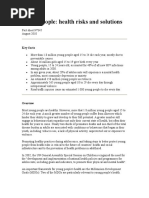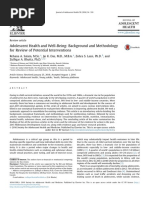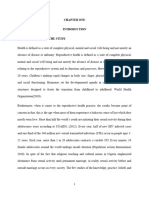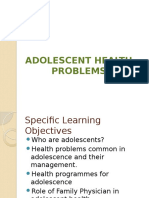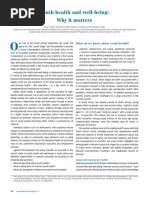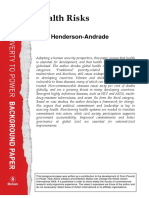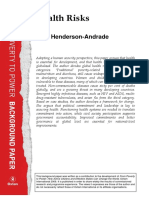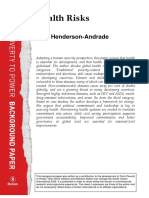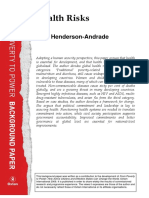0 ratings0% found this document useful (0 votes)
30 viewsAdolescent Health
Adolescent Health
Uploaded by
musondaaugustine07_4There are more adolescents today than ever before, with their numbers expected to continue rising. Adolescence presents many health challenges, as adolescents experience rapid development and often establish behaviors impacting future health. Leading causes of death for adolescents include injuries, violence, mental health issues, infectious diseases, and pregnancy complications.
Copyright:
© All Rights Reserved
Available Formats
Download as PPTX, PDF, TXT or read online from Scribd
Adolescent Health
Adolescent Health
Uploaded by
musondaaugustine07_40 ratings0% found this document useful (0 votes)
30 views30 pagesThere are more adolescents today than ever before, with their numbers expected to continue rising. Adolescence presents many health challenges, as adolescents experience rapid development and often establish behaviors impacting future health. Leading causes of death for adolescents include injuries, violence, mental health issues, infectious diseases, and pregnancy complications.
Copyright
© © All Rights Reserved
Available Formats
PPTX, PDF, TXT or read online from Scribd
Share this document
Did you find this document useful?
Is this content inappropriate?
There are more adolescents today than ever before, with their numbers expected to continue rising. Adolescence presents many health challenges, as adolescents experience rapid development and often establish behaviors impacting future health. Leading causes of death for adolescents include injuries, violence, mental health issues, infectious diseases, and pregnancy complications.
Copyright:
© All Rights Reserved
Available Formats
Download as PPTX, PDF, TXT or read online from Scribd
Download as pptx, pdf, or txt
0 ratings0% found this document useful (0 votes)
30 views30 pagesAdolescent Health
Adolescent Health
Uploaded by
musondaaugustine07_4There are more adolescents today than ever before, with their numbers expected to continue rising. Adolescence presents many health challenges, as adolescents experience rapid development and often establish behaviors impacting future health. Leading causes of death for adolescents include injuries, violence, mental health issues, infectious diseases, and pregnancy complications.
Copyright:
© All Rights Reserved
Available Formats
Download as PPTX, PDF, TXT or read online from Scribd
Download as pptx, pdf, or txt
You are on page 1of 30
ADOLESCENT HEALTH
A. Preamble
There are more adolescents today in the
world than ever before.
It has been estimated that there are 1.2
billion adolescents (one sixth of the
global population) .
This number is expected to rise,
particularly in low- and middle-income
countries
ADOLESCENT HEALTH
A. Preamble
Adolescence is a critical stage of human
development
It comes at a time before a person
transitions into adulthood and comes
along with a myriad of challenges,
depending on their upbringing.
One of such challenges borders on
health
ADOLESCENT HEALTH
A. Preamble
According to the World Health
Organisation (WHO), adolescence is the
phase of life between childhood &
adulthood (from 10 – 19 years).
It is a unique stage of human
development & an important period for
laying the foundations of good health.
ADOLESCENT HEALTH
A. Preamble
Adolescents experience rapid physical,
cognitive & psychosocial growth.
This affects how they feel, think, and
make decisions about their health; as
well as how they interact with the world
around them.
ADOLESCENT HEALTH
A. Preamble
The adolescent years witness significant
deaths, illnesses & injury.
During this phase, adolescents establish
patterns of behaviour related to diet,
physical activity, substance use & sexual
activity – that can potentially;
Protect their health & the health of
others around them.
Put their health at risk now & in the
future
ADOLESCENT HEALTH
B. Adolescent health risks
An estimated 1.1 million adolescents die each
year.
Causes of morbidity & mortality among
adolescents differ by sex & age; and also by
geographic region.
Among the 10-14 year olds, leading risks for
health are related to water, hygiene, &
sanitation.
Risks for 15-19-year-olds are more often
related to behaviours such as alcohol & drug
abuse & unsafe sex
Older adolescent girls are disproportionately
affected by intimate partner violence
ADOLESCENT HEALTH
C. Adolescent health risks
1. Main health issues
a) Injuries
Un-intentional injuries are the
leading cause of death & disability
among adolescents.
In 2019, nearly 100,000 adolescents
died as a result of road traffic
accidents.
Many of those who died were
vulnerable road users (pedestrians).
ADOLESCENT HEALTH
C. Adolescent health risks
1. Main health issues
b) Drowning
Drowning is also among the top
causes of death among
adolescents
More than 40, 000 adolescents
(over three quarters of them boys),
are estimated to have drowned in
2019.
ADOLESCENT HEALTH
C. Adolescent health risks
1. Main health issues
c) Violence
Interpersonal violence is among the
leading causes of death in
adolescents & young people
globally.
Its prominence varies substantially by
world region.
It causes nearly a third of all
adolescent male deaths in low-&
middle-income countries in Americas
ADOLESCENT HEALTH
C. Adolescent health risks
1. Main health issues
c) Violence
According to global school-based student
health survey, 42% of adolescent boys &
37% of adolescent girls were exposed to
bullying in 2019.
Sexual violence also affects a significant
proportion of youth: 1 in 8 people report
sexual abuse.
Violence also increases risks of injury,
HIV/STIs, mental health problems, poor
school performance, early pregnancy,
reproductive health problems, CDs &
NCDs.
ADOLESCENT HEALTH
C. Adolescent health risks
1. Main health issues
d) Mental health
Mental health conditions account for 16%
of the global burden of disease & injury in
people aged 10-19 years.
Half of all mental health disorders in
adulthood start by age 14, but most cases
are undetected & untreated.
Depression is one of the leading causes of
illness & disability among adolescents.
In many instances, depression leads to
suicide, which is the second leading cause
of death in people aged 15-19 years.
ADOLESCENT HEALTH
C. Adolescent health risks
1. Main health issues
d) Mental health
Many factors have an impact on the well-
being & mental health of adolescents.
Violence, stigma, exclusion, & living in
humanitarian & fragile settings can
increase risks of developing mental health
problems.
Consequences of not addressing
adolescent mental health conditions
extend to adulthood, impairing both
physical & mental health & limiting
opportunities to lead fulfilling lives as
adults.
ADOLESCENT HEALTH
C. Adolescent health risks
1. Main health issues
e) Alcohol & drug use
Drinking alcohol among adolescents is a major
concern in many countries.
Globally, more than a quarter of all people
aged 15-19 yrs (155 million) are current
drinkers
It impairs self-control & increase riky sexual
behaviours such as unsafe sex or dangerous
drinking.
It is an underlying cause of injuries, violence &
premature deaths.
It also causes health problems in later life &
affects life expectancy.
ADOLESCENT HEALTH
C. Adolescent health risks
1. Main health issues
e) Alcohol & drug use
Cannabis is the most widely used
psychoactive drug among young people
with about 4.7% of people aged 15-16 yrs
using it at least once in 2018.
Alcohol & drug use in children &
adolescents is associated with
neurocognitive alterations which can lead
to behavioural, emotional, social &
academic problems in later life.
ADOLESCENT HEALTH
C. Adolescent health risks
1. Main health issues
f) Tobacco use
Globally, at least 1 in 10 adolescents aged
13-15 years uses tobacco.
Vast majority of people using tobacco today
began doing so when they were adolescents.
The consequences of tobacco are well
documented (heightened risks of developing
cancer & other respiratory infections).
ADOLESCENT HEALTH
C. Adolescent health risks
1. Main health issues
g) HIV/AIDS
An estimated 1.7 million adolescents were
living with HIV in 2019.
The majority of these were living in Africa.
Currently, adolescents account for 10% of new
adult HIV infections, with three quarters
among girls.
Worse still, adolescents living with HIV have
limited access to ART, problems with
adherence to treatment, retention in care &
viral suppression.
Compounding this problem is limited access
to adolescent-friendly services
ADOLESCENT HEALTH
C. Adolescent health risks
1. Main health issues
h) Other infectious diseases
Diarrhoea & lower respiratory tract infections
(pneumonia) are estimated t be among the
top 10 causes of death for adolescents 10-14
years.
These 2, along with meningitis, are all among
the top 5 causes of adolescent death in
African low-& middle-income countries.
Human Papilloma Virus that normally occurs
after onset of sexual activity can lead to both
short-term disease (genital warts) during
adolescence, but more also leads to cervical
cancer.
ADOLESCENT HEALTH
C. Adolescent health risks
1. Main health issues
i) Early pregnancy & childbirth
Approximately 12 million girls aged 15-19
years & at least 777, 000 girls under 15 years
give birth each year in developing countries.
The UN Population Division puts the global
adolescent birth rate in 2020 at 41 per 1000
girls.
Complications from pregnancy & childbirth
are among the leading causes of death for
girls aged 15-19 years globally.
ADOLESCENT HEALTH
C. Adolescent health risks
1. Main health issues
j) Nutrition & micronutrient deficiencies
Iron deficiency anaemia was the second
leading cause of years lost by adolescents to
death & disability in 2019.
ADOLESCENT HEALTH
C. Adolescent health risks
1. Main health issues
k) Undernutrition & Obesity
Many boys & girls in developing countries
enter adolescence undernourished, making
them vulnerable to disease & early death.
At the other end of the spectrum, the
number of adolescents who are overweight
or obese is increasing in low- middle- &
high-income countries.
In 2016, over 1 in 6 adolescents aged 10-
19 years was overweight.
ADOLESCENT HEALTH
C. Adolescent health risks
2. Solution to adolescent health
a) Injuries
There is need to ensure that road
safety law are more comprehensive,
enforced & strengthened.
Young drivers need advice on safe
driving
Laws that prohibit driving under the
influence of alcohol need to be strictly
enforced
ADOLESCENT HEALTH
C. Adolescent health risks
2. Solution to adolescent health
b) Drowning
Teaching children & adolescents to
swim is an essential intervention to
prevent these deaths
ADOLESCENT HEALTH
C. Adolescent health risks
2. Solution to adolescent health
c) Violence
Effective prevention & response
strategies need to be enhanced
Address school-based bullying
Effective & empathetic care for
adolescent survivors of violence
Promote parenting & early
childhood development
ADOLESCENT HEALTH
C. Adolescent health risks
2. Solution to adolescent health
c) Mental Health
Provide adolescent with
psychosocial support in schools &
communities
Support programmes that seek to
strengthen ties between
adolescents & their families &
improve quality of home
environments
Mental health problems to be
handled by competent personnel.
ADOLESCENT HEALTH
C. Adolescent health risks
2. Solution to adolescent health
d) Alcohol & drug use
Prevention of alcohol & drug use
should include population-based
strategies & interventions at all
levels (school, family, community,
individual, etc.)
Increase minimum age for buying
& consuming alcohol.
Eliminate marketing & advertising
of alcohol to minors
ADOLESCENT HEALTH
C. Adolescent health risks
2. Solution to adolescent health
e) HIV/AIDS
Adolescents need to know how to
how to protect themselves from
HIV infection
Access VMMC, condoms,
PEP/PrEP, ART, etc.
ADOLESCENT HEALTH
C. Adolescent health risks
2. Solution to adolescent health
f) Other infections
Vaccination against HPV infection in
early adolescence should be
prioritized.
ADOLESCENT HEALTH
C. Adolescent health risks
2. Solution to adolescent health
g) Early pregnancy & child birth
Adolescents need to have
comprehensive sexuality education.
CSE teaches about the cognitive,
emotional, physical & social
aspects of sexuality.
Better access to contraceptive
information & services can
reduce the number of girls
becoming pregnant & giving
birth at a tender age
ADOLESCENT HEALTH
C. Adolescent health risks
2. Solution to adolescent health
h) Nutrition & micronutrient
deficiency
Develop healthy eating habits in
adolescence
Reduce marketing of foods high
in saturated fats, trans-fatty
acids, free-sugars or salts
ADOLESCENT HEALTH
3. Conclusion
What do adolescents need to grow &
develop in good health
a) age-appropriate comprehensive
sexuality education
b) opportunities to develop life skills
c) adolescent-friendly health
services
d) safe & supportive social
environments
You might also like
- OR2019 02 Modeling ExamplesDocument12 pagesOR2019 02 Modeling ExamplesUtku KesenNo ratings yet
- Introduction & Health Problems in AdolescenceDocument31 pagesIntroduction & Health Problems in AdolescenceArun KumarNo ratings yet
- Adolescents: Health Risks and Solutions: Key FactsDocument1 pageAdolescents: Health Risks and Solutions: Key FactsAlyssa Mae Mejia CendañaNo ratings yet
- Physical SelfDocument12 pagesPhysical SelfTeofilo Palsimon Jr.No ratings yet
- Adolescents: Health Risks and Solutions: Key FactsDocument3 pagesAdolescents: Health Risks and Solutions: Key FactsladyanjaniNo ratings yet
- Adolescent Health UpdatedDocument18 pagesAdolescent Health Updatedanon_588049728No ratings yet
- Diseases in AdolescenceDocument10 pagesDiseases in AdolescenceShreya YadavNo ratings yet
- BACKGROUNDDocument3 pagesBACKGROUNDMUWANGUZI ALEXANDERNo ratings yet
- Adolecents ProblemsDocument27 pagesAdolecents Problemstaongasiliya178No ratings yet
- WHO FRH ADH 98.18 Rev.1Document24 pagesWHO FRH ADH 98.18 Rev.1FazalNo ratings yet
- Adolescents: Health Risks and Solutions: Key FactsDocument8 pagesAdolescents: Health Risks and Solutions: Key Factspuskesmas beloNo ratings yet
- Unit 5 Adolescent Health: StructureDocument22 pagesUnit 5 Adolescent Health: StructurelipidusNo ratings yet
- Lecture 11, Adolescent Health, Maternal & Child HealthDocument16 pagesLecture 11, Adolescent Health, Maternal & Child HealthHHGV JGYGUNo ratings yet
- Adolescent Mental Health: Key FactsDocument6 pagesAdolescent Mental Health: Key FactsCostas1373No ratings yet
- Literature ReviewDocument4 pagesLiterature ReviewfebiwNo ratings yet
- Adolescen and Their HelthDocument12 pagesAdolescen and Their HelthMett RushitiNo ratings yet
- Quality of Life in YouthDocument53 pagesQuality of Life in YouthhananNo ratings yet
- Youth Mental Health Challenges AheadDocument3 pagesYouth Mental Health Challenges AheadIndah HermawatiNo ratings yet
- Non Communicable Diseases and Adolescents 8211 An Opportunity For ActionDocument20 pagesNon Communicable Diseases and Adolescents 8211 An Opportunity For Actionhamdallah alaganganNo ratings yet
- Young People: Health Risks and Solutions: Key FactsDocument26 pagesYoung People: Health Risks and Solutions: Key Factsharvina sawitriNo ratings yet
- WHO FWC MCA 14.05 Eng PDFDocument20 pagesWHO FWC MCA 14.05 Eng PDFsofiabloemNo ratings yet
- Adolescent MalnutritionDocument13 pagesAdolescent MalnutritionIma SoniaNo ratings yet
- Adolescent and Youth Health Development Program: Accidents and Accident-Prone Activities Among AdolescentsDocument4 pagesAdolescent and Youth Health Development Program: Accidents and Accident-Prone Activities Among AdolescentsMaikka IlaganNo ratings yet
- Western Mindanao State University College of Nursing Zamboanga CityDocument16 pagesWestern Mindanao State University College of Nursing Zamboanga CityRoshin TejeroNo ratings yet
- Indiviual ReportDocument6 pagesIndiviual Reportiqraibrahim2009No ratings yet
- Covid 19Document4 pagesCovid 19jai.0238No ratings yet
- Health and Technology REPORT 022520Document25 pagesHealth and Technology REPORT 022520Tadala NsaliwaNo ratings yet
- Adolescent Health and Well-Being: Background and Methodology For Review of Potential InterventionsDocument7 pagesAdolescent Health and Well-Being: Background and Methodology For Review of Potential InterventionsWiwit VitaniaNo ratings yet
- Iehp 114Document11 pagesIehp 114Swati SahniNo ratings yet
- RRL FinalDocument7 pagesRRL FinalBRIGINO, ALYSSA BERNICE I.No ratings yet
- Notes of Sexual & Adolescent Reproductive Health From Lecturer, Year 4 Upgrading, 2019-2020Document35 pagesNotes of Sexual & Adolescent Reproductive Health From Lecturer, Year 4 Upgrading, 2019-2020SONGA AmriNo ratings yet
- Teen Health ClinicDocument2 pagesTeen Health Clinicseo expertNo ratings yet
- Project - FaizalDocument9 pagesProject - FaizalrayonneeemdyNo ratings yet
- Child and adolescent mental health policy briefDocument8 pagesChild and adolescent mental health policy briefharem bakirNo ratings yet
- Adolescent PregnancyDocument24 pagesAdolescent PregnancyKyler DarkNo ratings yet
- CDC Childhood Injury ReportDocument116 pagesCDC Childhood Injury ReportTINALEETNT723No ratings yet
- Draft Research Proposal Chapter 1 PregancyDocument19 pagesDraft Research Proposal Chapter 1 PregancyEnock MwiimbiNo ratings yet
- Adolescents HealthDocument5 pagesAdolescents HealthJahidul AlamNo ratings yet
- Adolescent HealthDocument47 pagesAdolescent HealthsushmaNo ratings yet
- tmp65DD TMPDocument9 pagestmp65DD TMPFrontiersNo ratings yet
- tmp129F TMPDocument9 pagestmp129F TMPFrontiersNo ratings yet
- CHN 1 Topic 1. A Handout in Overview of Public Health Nursing in The Phils.Document11 pagesCHN 1 Topic 1. A Handout in Overview of Public Health Nursing in The Phils.DANIAH ASARI. SAWADJAANNo ratings yet
- Health RisksDocument21 pagesHealth RisksOxfamNo ratings yet
- Health RisksDocument21 pagesHealth RisksOxfamNo ratings yet
- Health RisksDocument21 pagesHealth RisksOxfamNo ratings yet
- Health RisksDocument21 pagesHealth RisksOxfamNo ratings yet
- Health RisksDocument21 pagesHealth RisksOxfamNo ratings yet
- Health RisksDocument21 pagesHealth RisksOxfamNo ratings yet
- Health RisksDocument21 pagesHealth RisksOxfamNo ratings yet
- Health RisksDocument21 pagesHealth RisksOxfamNo ratings yet
- Health RisksDocument21 pagesHealth RisksOxfamNo ratings yet
- Health RisksDocument21 pagesHealth RisksOxfamNo ratings yet
- Health RisksDocument21 pagesHealth RisksOxfamNo ratings yet
- Health RisksDocument21 pagesHealth RisksOxfamNo ratings yet
- Health RisksDocument21 pagesHealth RisksOxfamNo ratings yet
- Health RisksDocument21 pagesHealth RisksOxfamNo ratings yet
- Health RisksDocument21 pagesHealth RisksOxfamNo ratings yet
- Health RisksDocument21 pagesHealth RisksOxfamNo ratings yet
- Health RisksDocument21 pagesHealth RisksOxfamNo ratings yet
- Performance Management - With ExamplesDocument22 pagesPerformance Management - With ExamplesFalcon City100% (1)
- Sales Doctrines (SIENNA FLORES)Document15 pagesSales Doctrines (SIENNA FLORES)Nori LolaNo ratings yet
- Net Metering - Vendor RegistrationDocument4 pagesNet Metering - Vendor RegistrationSyeda Fatima aliNo ratings yet
- NP000615 SNA Group ComponentDocument19 pagesNP000615 SNA Group ComponentSuzan DahitNo ratings yet
- 3 Powerful Tips To Overcome FearDocument2 pages3 Powerful Tips To Overcome FearkentalzNo ratings yet
- Abelmarle Referencia KF-868 PDFDocument24 pagesAbelmarle Referencia KF-868 PDFEdgar Hector Garcia100% (1)
- Galaxy Health Insurance - MOUDocument12 pagesGalaxy Health Insurance - MOUmailmesnhNo ratings yet
- Mathryn Obligado BSED - Mathematics 2 PE3 Activity 1Document6 pagesMathryn Obligado BSED - Mathematics 2 PE3 Activity 1Min MatmatNo ratings yet
- Posistion Paper (Group 6)Document6 pagesPosistion Paper (Group 6)Random PersonNo ratings yet
- Practice ExercisesDocument6 pagesPractice ExercisesMyunimintNo ratings yet
- Defining Relative ClausesDocument3 pagesDefining Relative ClausesanytanyaNo ratings yet
- 0.0 PHD Dissertation Applying Identity Theory To The Study of Stigmatized Identities PDFDocument124 pages0.0 PHD Dissertation Applying Identity Theory To The Study of Stigmatized Identities PDFtotallylegalNo ratings yet
- DownloadDocument8 pagesDownloadmax paxNo ratings yet
- Civil Services Result 2009Document23 pagesCivil Services Result 2009anoopsinhghNo ratings yet
- QP-04 Internal AuditDocument5 pagesQP-04 Internal AuditScha Affin100% (1)
- Phy JSS 3Document22 pagesPhy JSS 3mubarakoak1No ratings yet
- FIRST AID ThesisDocument87 pagesFIRST AID ThesisScribdTranslationsNo ratings yet
- Chiral Analysis: Advances in Spectroscopy, Chromatography and Emerging Methods P L Polavarapu download pdfDocument51 pagesChiral Analysis: Advances in Spectroscopy, Chromatography and Emerging Methods P L Polavarapu download pdfmoninsonamyl100% (4)
- The Death and Life of Great American CitiesDocument5 pagesThe Death and Life of Great American CitiesMaría Fernanda P. AscorraNo ratings yet
- Assistant Community Manager: Hong Kong Certificated Entrance ExaminationDocument1 pageAssistant Community Manager: Hong Kong Certificated Entrance ExaminationAlfatah muhumedNo ratings yet
- Questionnaire On Consumer BehaviourDocument9 pagesQuestionnaire On Consumer BehaviourMAHIPAL CHANDAN100% (1)
- Em Social 3Document6 pagesEm Social 3Vijaya RajuNo ratings yet
- Maestoso, Andante and Vivace. The Horns Enter With A Three Chord Statement ThatDocument1 pageMaestoso, Andante and Vivace. The Horns Enter With A Three Chord Statement ThatYinNo ratings yet
- Mies Van Der Rohe A Critical Biography New and Revised Edition Franz Schulze & Edward Windhorst All Chapter Instant DownloadDocument34 pagesMies Van Der Rohe A Critical Biography New and Revised Edition Franz Schulze & Edward Windhorst All Chapter Instant Downloadyakloaudelo70100% (1)
- An Introduction To International Economics: Dominick Salvatore John Wiley & Sons, IncDocument42 pagesAn Introduction To International Economics: Dominick Salvatore John Wiley & Sons, IncTuyết TrinhNo ratings yet
- US Board and EUDocument55 pagesUS Board and EUschwarzardengrossNo ratings yet
- The Lake Titicaca Giant Frog (La Rana Gigante Del Lago Titicaca)Document3 pagesThe Lake Titicaca Giant Frog (La Rana Gigante Del Lago Titicaca)Jordhan jared Ordóñez De la cruzNo ratings yet
- Conguring As Java To Accept Logon TicketsDocument51 pagesConguring As Java To Accept Logon Ticketsm.fadlallah8191No ratings yet
- Financing Enterprises (Custom Edition) - (Chapter 12 Money Banks and Interest Rates)Document14 pagesFinancing Enterprises (Custom Edition) - (Chapter 12 Money Banks and Interest Rates)alexandrastojanovska01No ratings yet



















